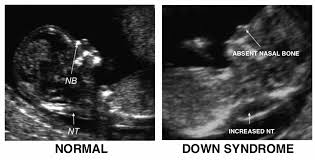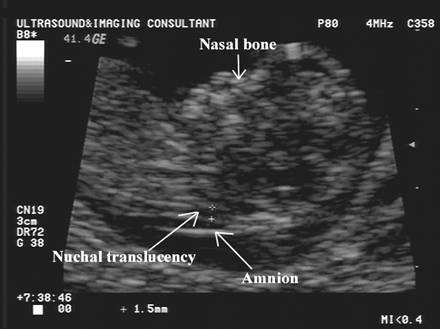Pregnancy is a time when people tend to learn a lot of new terminology. Among the many terms you will learn and become familiar with is a nuchal scan. This is the ultrasound typically completed at the 12 week mark of pregnancy. This scan measures a tiny bit of fluid located behind the baby's neck, known as nuchal translucency. A sample of the mother's blood, an evaluation of the baby's nasal bone and a consultation of the nuchal translucency thickness all combine to let the parents know their child's chances of having Down syndrome.
Nuchal Translucency Normal Range Chart
When the nuchal scan is done, the doctor will share the results with you. At that time, it is important to understand what a normal measurement is. For a baby that is between 45 mm and 84 mm in size, a normal measurement is anything less than 3.5 mm. The NT grows in proportion to the baby.
A doctor considers any baby with an NT less than 1.3 mm to be low-risk in terms of Down syndrome. Meanwhile, a baby with an NT of 6 is considered high risk for Down syndrome and also other potential chromosomal abnormalities. The chart below shows typical measurements considered normal at that stage of development.
|
Pregnancy Mark |
Normal Measurement |
|
At 11 Weeks |
Up to 2mm *Note: 9 of 10 babies with thickness 2.5-3.5mm will be normal. |
|
12-13 Weeks |
1.7mm (50th percentile thickness) 2.8mm (95th percentile thickness) |
Why Should You Have a Nuchal Translucency Ultrasound?
Studies have shown that a thicker NT measurement is caused by fluid increases, and those increases are because certain conditions are present in the fetus. Therefore, the increased measurement of the NT can show the baby has chromosome abnormalities like Trisomy 13, 18 and 21 or structural issues like abnormalities of the heart. However, this does not mean the baby will have a problem. It only means the risk is higher.
- Trisomy 21 (also known as Down syndrome)
This condition means a baby has an extra chromosome 21 in every cell of their body. This affects 1 in 600 babies born in the US. Certain issues like intellectual delays and physical issues are connected to the additional chromosome, leading to heart defects of intestinal issues.

- Trisomy 18 (also known as Edward syndrome)
This condition leads to severe birth defects, typically causing the baby to die during development or shortly after birth. The baby will have an extra chromosome 18 in each cell of their body.
- Trisomy 13 (also known as Patau syndrome)
For this condition, each cell contains an extra chromosome 13. This condition results in severe birth defects, typically many at once. These babies also do not have high life expectancy, with death possible during the pregnancy or shortly after birth.
The nuchal translucency normal range chart helps prepare the parents for these possibilities if the NT is out of normal range.
How Is the Nuchal Translucency Scan Done?
First of all, the timing of this particular scan is very important. A woman must be 11 weeks, 2 days pregnant to 14 weeks, one day pregnant to have this scan for the best results. During this time, the baby's length from crown to rump is between 45 mm and 84 mm. Typically, a routine scan to check on development is done during this time frame anyway. It is during this time that the baby's heartbeat can typically be heard and measured for the first time as well.
 The scan is completed using the normal ultrasound equipment and using the wand over the stomach, as opposed to vaginally. There is no pain, although pressure may be exerted to get the best picture using the handheld wand. A cool gel will be placed on the stomach prior to the start of the scan.
The scan is completed using the normal ultrasound equipment and using the wand over the stomach, as opposed to vaginally. There is no pain, although pressure may be exerted to get the best picture using the handheld wand. A cool gel will be placed on the stomach prior to the start of the scan.
The baby will be measured from the top of his (or her) head to the bottom of his or her spine during this scan. The width of the nuchal fluid at the base of the baby's neck is then measured. This is the area that looks black, while the skin of the baby looks like a white line.
Issues with the baby's skull and abdomen can be ruled out during this scan. You will also be able to see the baby's hands and feet and head, spine and limbs. A more detailed scan, which will be able to see anatomy, can be done around 20 weeks.
What If Your Test Result Is Abnormal?
The nuchal translucency normal range chart is a guideline during this scan. Therefore, it shows what can be normal and is normal for a number of babies. This does not mean your baby will have Down syndrome, however. This screen is shown to be able to identify the majority of Down syndrome babies. It does not mean you are likely to have a Down syndrome baby if the scan is outside the normal range. It also means that some Down syndrome babies are not detected by this scan and method of testing.
If there are concerns at this juncture, the options are available for more invasive testing like amniocentesis, if you so desire. If not, issues like spina bifida, club foot and cleft palate become more apparent at the 20-week scan.
How Accurate Is It?
This scan has been shown to detect 77% of babies who are born with Down syndrome. In an NT scan, however, there is a false positive of roughly five percent. This means the baby tests with a high risk yet does not end up having Down syndrome. Pairing the NT scan with a blood test lowers the likelihood of a false positive. This is because high levels of hCG and the hormone PAPP-A are found in babies with Down syndrome. So a high risk result of an NT scan and high levels of these hormones tend to provide accurate indications that a baby will have Down syndrome.
The rate of accuracy when a blood test and NT scan are done together increases to roughly 90%. However, with the combined test, the false positive rate is still five percent. Therefore, the nuchal translucency normal range chart remains a tool that can be helpful but is not a guarantee of an issue or lack of one.
